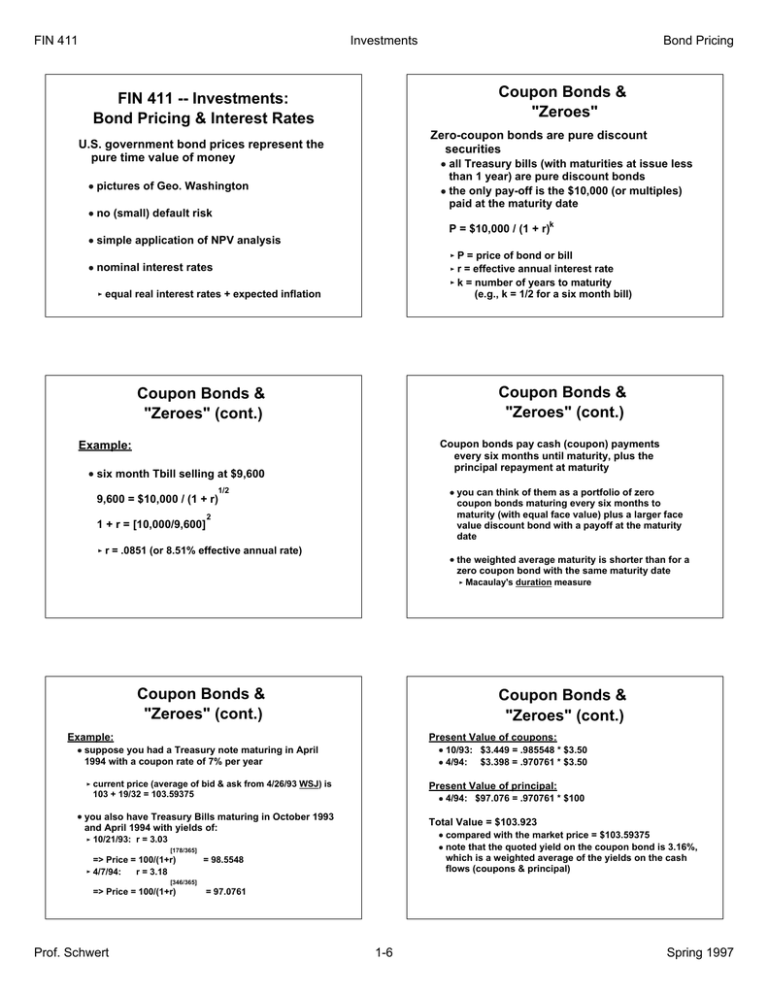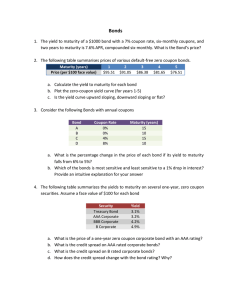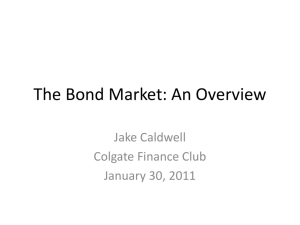Coupon Bonds & FIN 411 -- Investments: "Zeroes" Bond Pricing & Interest Rates
advertisement

FIN 411 Investments Coupon Bonds & "Zeroes" FIN 411 -- Investments: Bond Pricing & Interest Rates Zero-coupon bonds are pure discount securities U.S. government bond prices represent the pure time value of money all Treasury bills (with maturities at issue less than 1 year) are pure discount bonds the only pay-off is the $10,000 (or multiples) paid at the maturity date pictures of Geo. Washington no (small) default risk k P = $10,000 / (1 + r) simple application of NPV analysis P = price of bond or bill r = effective annual interest rate k = number of years to maturity (e.g., k = 1/2 for a six month bill) nominal interest rates equal real interest rates + expected inflation Coupon Bonds & "Zeroes" (cont.) Coupon Bonds & "Zeroes" (cont.) Coupon bonds pay cash (coupon) payments every six months until maturity, plus the principal repayment at maturity Example: six month Tbill selling at $9,600 1/2 you can think of them as a portfolio of zero coupon bonds maturing every six months to maturity (with equal face value) plus a larger face value discount bond with a payoff at the maturity date 9,600 = $10,000 / (1 + r) 1 + r = [10,000/9,600] Bond Pricing 2 r = .0851 (or 8.51% effective annual rate) the weighted average maturity is shorter than for a zero coupon bond with the same maturity date Macaulay's duration measure Coupon Bonds & "Zeroes" (cont.) Coupon Bonds & "Zeroes" (cont.) Present Value of coupons: Example: 10/93: $3.449 = .985548 * $3.50 4/94: $3.398 = .970761 * $3.50 suppose you had a Treasury note maturing in April 1994 with a coupon rate of 7% per year current price (average of bid & ask from 4/26/93 WSJ) is 103 + 19/32 = 103.59375 Present Value of principal: 4/94: $97.076 = .970761 * $100 you also have Treasury Bills maturing in October 1993 and April 1994 with yields of: Total Value = $103.923 compared with the market price = $103.59375 note that the quoted yield on the coupon bond is 3.16%, which is a weighted average of the yields on the cash flows (coupons & principal) 10/21/93: r = 3.03 [178/365] => Price = 100/(1+r) 4/7/94: r = 3.18 = 98.5548 [346/365] => Price = 100/(1+r) Prof. Schwert = 97.0761 1-6 Spring 1997 FIN 411 Investments Bond Pricing Corporate Bonds & Default Risk Corporate Bonds & Default Risk Rating agencies (Moody's, S&P, Fitch, etc.) publish ratings for corporate and municipal debt Corporate bonds differ from government bonds with the same coupon and principal terms because there is some chance that the corporation will not be able to make all of the promised payments (on time or at all) intended to reflect default risk Aaa is highest Moody's rating Baa is the lowest "investment grade" bond eligible for purchase by most banks, etc. Default risk below Baa are "junk" (high yield) bonds somewhat like equity, since pay-offs are strongly linked to the health of the company expected cash flows = prob of payment * promised payment yields are higher (& prices lower) for higher amounts of default risk not (necessarily) non-diversifiable risk Term Structure of Interest Rates Discount vs. Coupon Term Structures (April 26, 1993, WSJ) Discount Term Structure 8% Term structure refers to the shape of the plot of yields to maturity as a function of the maturity date Coupon Term Structure Annual Yield to Maturity 7% Discount term structure reflects yields on Tbills & zero coupon (Strip) bonds this is the pure price of receiving $1 at some time in the future Coupon term structure reflects yields on coupon bonds 6% 5% Since term structure is rising, Coupon term structure is below Discount term structure 4% 3% these are each weighted averages of the yields associated with the intermediate and final cash flows 2% 0 5 10 15 20 25 30 Term to Maturity, Years Term Structure & Forward Rates(cont.) Term Structure & Forward Rates In general: Think of the yield on a 2-period bond in terms of the yield on the 1-period bond and the forward rate of interest from period 1 to 2: k (1 + y ) k 2 = (1 + y ) (1 + r ) 1 2 (1 + r ) k r is the forward rate for period k (note: r = y ) k 1 1 k where y is the yield to maturity on a 1-period strip and 1 (1 + y ) k r is the forward rate for period 2 2 Prof. Schwert k-1 where y is the yield to maturity on a k-period strip and k 2 (1 + y ) k-1 = (1 + y ) = (1 + r ) (1 + r ) . . . (1 + r ) 1 2 k so yield to maturity is simply a geometric average of the forward rates 7-12 Spring 1997 FIN 411 Investments Bond Pricing Term Structure & Forward Rates(cont.) Discount Term Structure & Forward Rates (April 26, 1993, WSJ) Discount Term Structure r k > y Annual Yield to Maturity or Forward Rates If the term structure is rising, then the forward rate is above the spot rate k and vice versa Holding period returns from period to period depend on movements in the term structure: increases in interest rates cause bond prices to fall shift in term structure movements along the term structure (no shifts) cause returns to equal forward rates 9% 8% 7% 6% falling term structure 5% 4% rising term structure 3% 2% 0 5 10 15 20 25 30 Term to Maturity, Years Term Structure & Forward Rates(cont.) Interest Rates & Inflation Note that forward rates are not just a theoretical concept As we saw earlier, one important reason why nominal interest rates are different for different maturities (at a point in time), and why nominal interest rates of the same maturity are different at different points in time is You can invest in a forward contract, buying a k-period strip and short-selling a (k-1) period strip you receive the interest rate r during k period k EXPECTED INFLATION We will see this concept again when we get to the discussion of futures contracts real rates = nominal rates - expected inflation Term Structure & Profit Opportunities Term Structure & Profit Opportunities(cont.) Means that it should not pay to "play" the term structure Term structure may be the best example of an efficient market buy long-term bonds because they have higher yields? Why not? lots of traders & money information widely available and no one has cheap access to better info about macroeconomy if rates rise in the future, bond prices will fall, so returns will be lower than implied by forward rates transaction costs are very low scope of uncertainty is limited set of possible outcomes is small unlike future events in a corporation also, rising forward rates may imply that the inflation rate (or the real rate of interest) will be much higher in the future than it is today This all implies that "profit opportunities" should be scarce Prof. Schwert Discount Forward Rates 13-18 Spring 1997 FIN 411 Investments Term Structure & Profit Opportunities(cont.) Term Structure of Interest Rates: Questions Implications for Original Clinton Budget Plan: 1. Define circumstances under which a financing strategy such as Clinton's could be viewed as an expenditure cut (a savings for taxpayers). Be as explicit as possible. largest single source of budget cuts is from borrowing at the short end of the term structure! Is this an "expenditure cut"? In the short run, less cash flows will leave the Treasury In the longer run (say, after about 4 years), the cost of borrowing short-term will rise (as will the cost of borrowing long-term) future administrations will have to pay for the decision to borrow short today No free lunch (just put it someone else's bill) Prof. Schwert Bond Pricing 2. Why do you think that short-term interest rates are relatively low today? 3. Why do you think that long-term interest rates are low (by historical standards), but also high (relative to short rates) today? 19-24 Spring 1997








